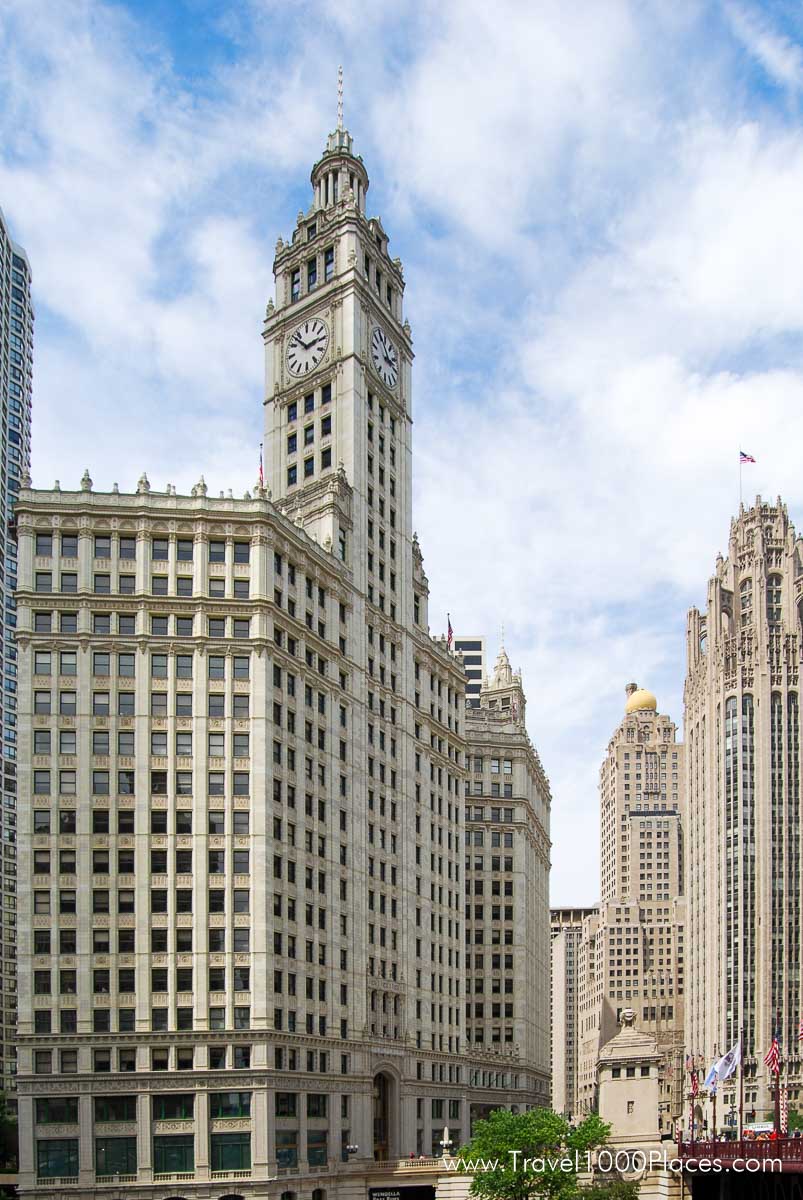
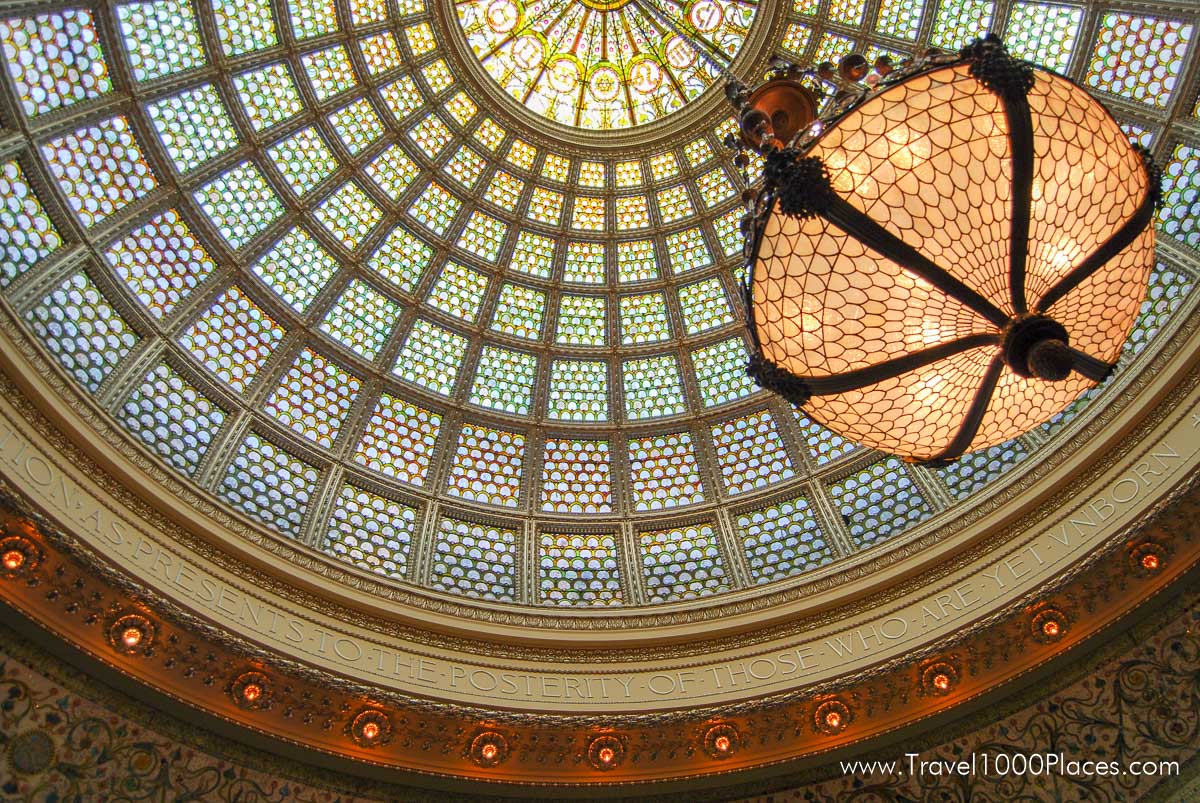
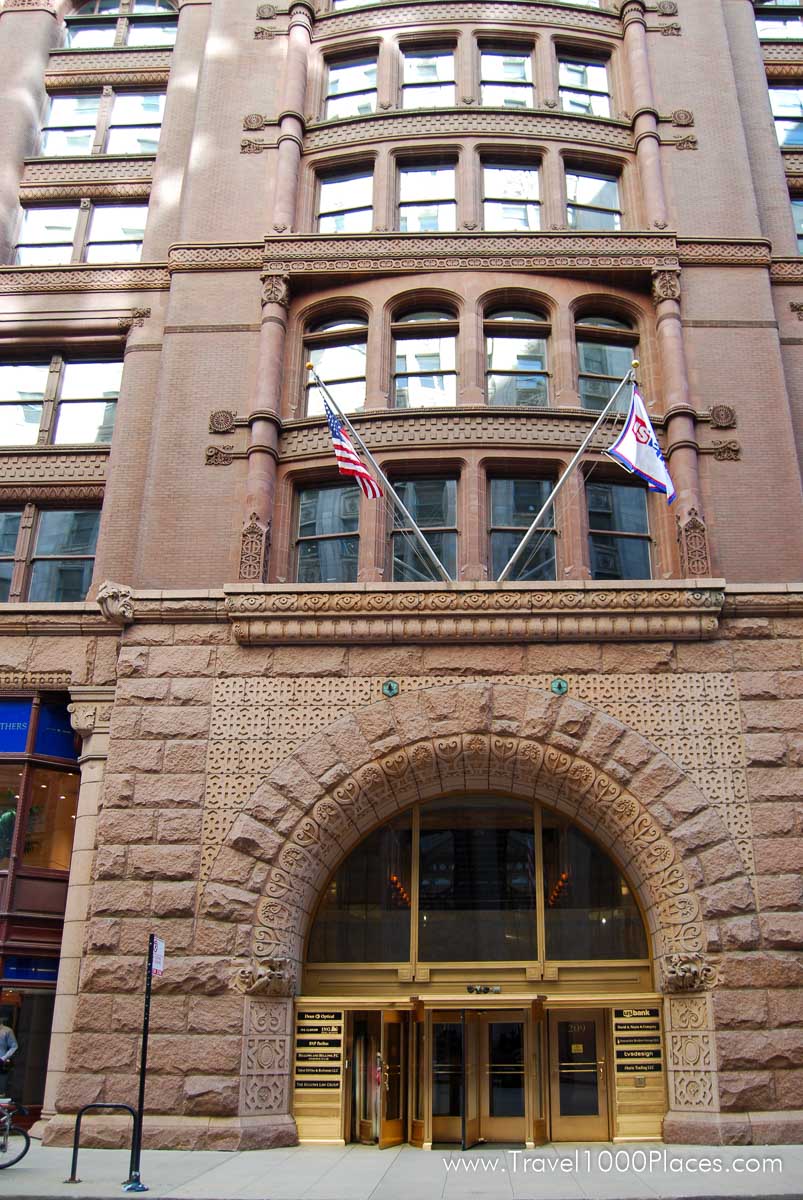
<– back to CHICAGO ARCHITECTURE main page, including more information about the Chicago Architecture Center, a non-profit organization that offers tours and insight information.
Overview list
We’d like to introduce major highlights of the Chicago Architecture. Here’s our list:
- Federal Center and Plaza (Jackson Boulevard and Dearborn Street); work of Ludwig Mies van der Rohe
- 1886 Rookery Building, (LaSalle and Adams Streets); designed by Burnham and Root with a lobby remodeled by Frank Lloyd Wright.
->Read more further below. - Robie House, (5757 S. Woodlawn Avenue, near the University of Chicago); example of Wright’s Prairie School of architecture
->Read more further below. - Chicago Cultural Center (78 E. Washington Street)
- 1889 Auditorium Building, (Michigan Avenue and Congress Parkway)
->Read more further below. - Carson Pirie Scott store, (1899), 1 S. State Street
- Chicago Board of Trade Building, (LaSalle Street and Jackson Boulevard)
- Home Insurance Building, which was at the northeast corner of LaSalle and Adams Streets; Status: demolished in 1931
- Willis Tower (former Sears Tower), (bounded by Wacker Drive, Jackson Boulevard, Franklin Boulevard and Adams Street)
- AON Center, formerly the Amoco Building (200 E. Randolph Street)
- John Hancock Center, (875 N. Michigan Avenue)
- James R. Thompson Center, 100 W. Randolph Street
- Harold Washington Library Center, (400 S. State Street)
- Millennium Park
- Adler Planetarium
- Art Institute of Chicago’s new Modern Wing and Nichols Bridgeway, both designed by Renzo Piano
- NBC Tower, designed by Adrian Smith
- Marshall Field Store, (111 N. State Street)
- Shedd Aquarium, (1200 S Lake Shore Dr)
- Wrigley Building, 410 North Michigan Ave
- Glessner (John J.) House, (1800 Prairie Avenue)
- 190 S. LaSalle Street, by Philip Johnson;
- 333 W. Wacker Drive, by William Pederson;
- the serpentine River City, by Bertrand Goldberg;
- Spertus Institute of Jewish Studies (610 S. Michigan), designed by Krueck and Sexton;
- 900 N. Michigan Avenue, housing Bloomingdale’s and a shopping mall, also by William Pederson
More details
1886 Rookery Building (LaSalle and Adams Streets)
The 1886 Rookery Building (LaSalle and Adams Streets) designed by Burnham and Root with a lobby remodeled by Frank Lloyd Wright is a Chicago landmark.

National Historic Landmark
Statement of Significance (as of designation – May 15, 1975): Completed in 1886 at a cost of $1.5 million, this 11 story building is a prime example in the development of multi-story commercial structures. Its use of skeletal construction and fine ornamental detail place it in the mainstream of “Chicago School” architecture. In 1905, its lobby was remodeled by Frank Lloyd Wright.
Address: 209 S La Salle St, Chicago, IL 60604
Robie House
An excellent example of Wright’s Prairie School of architecture is the Robie House (5757 S. Woodlawn Avenue), near the University of Chicago.
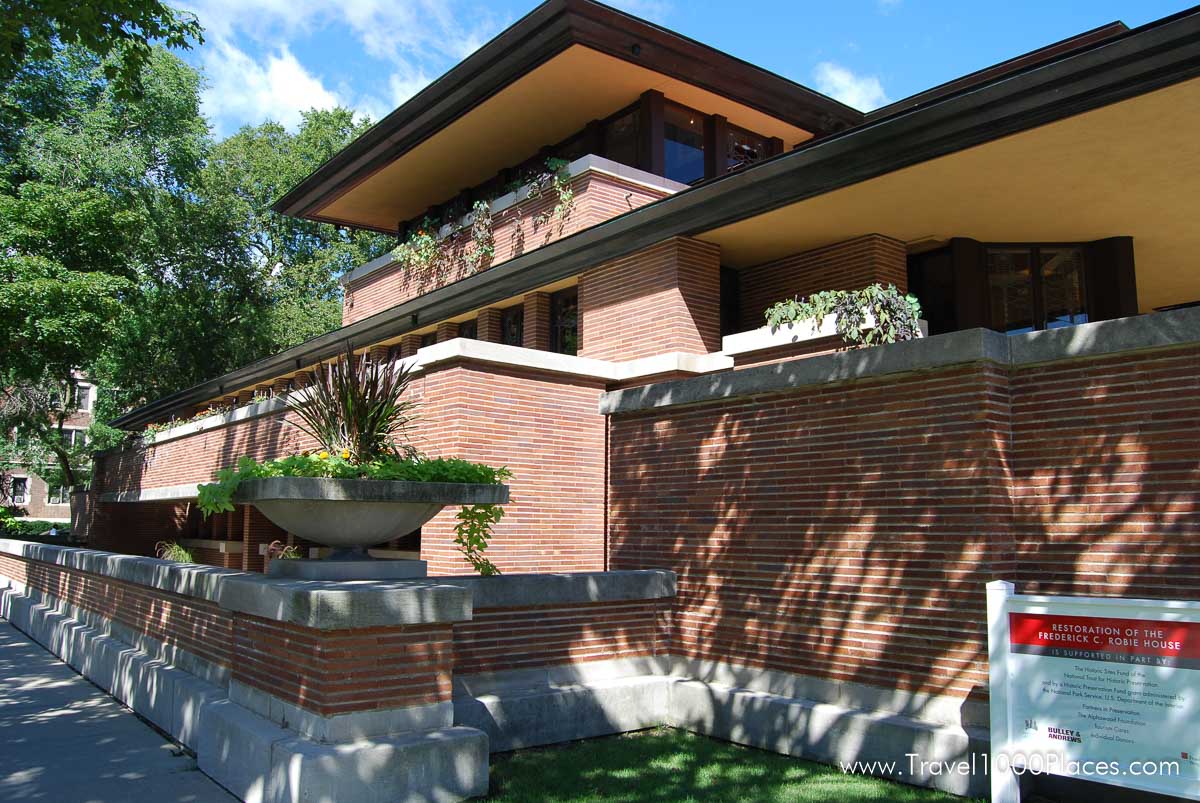
National Historic Landmark
Statement of Significance (as of designation – November 27, 1963):
The Robie House, constructed 1907-1909, was one of the seminal buildings in 20th century American architecture and won international acclaim for Frank Lloyd Wright. The house epitomizes Wright’s Prairie Style. Its broad horizontal masses and planes, almost more sculpture than architecture, and its clean, unadorned lines are recognizable by all those familiar with modern architecture.
Address: 5757 S Woodlawn Ave, Chicago, IL 60637
1889 Auditorium Building
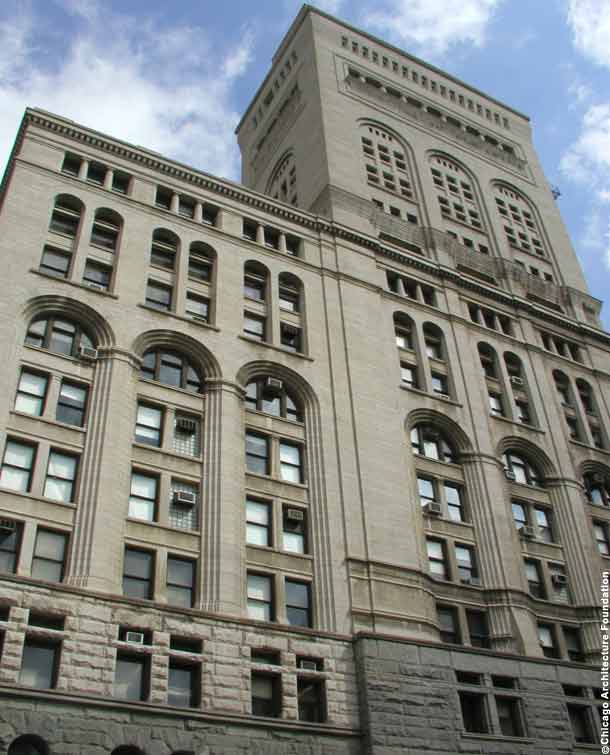
430 S. Michigan Ave.
The 1889 Auditorium Building (Michigan Avenue and Congress Parkway), designed by Louis Sullivan and Dankmar Adler, is still visited by many Chicagoans and visitors because it houses the Auditorium Theatre (Auditorium Theatre [auditoriumtheatre.org]), which ranks as one of the city’s finest performance spaces.
National Historic Landmark
Statement of Significance (as of designation – May 15, 1975):
Constructed 1886-1889, this structure grew out of Chicago’s need for a civic center housing primarily a concert hall and opera house, as well as space for political conventions, charity balls, etc.
Among the most important buildings in the history of modern architecture, it reveals Louis Sullivan’s developing ability to solve the aesthetic and functional design problems of tall buildings, and the capacity of Dankmar Adler to overcome engineering obstacles.
More on Wikipedia: Auditorium Building (Chicago) – Wikipedia
Carson Pirie Scott store (1899), now the Sullivan Center
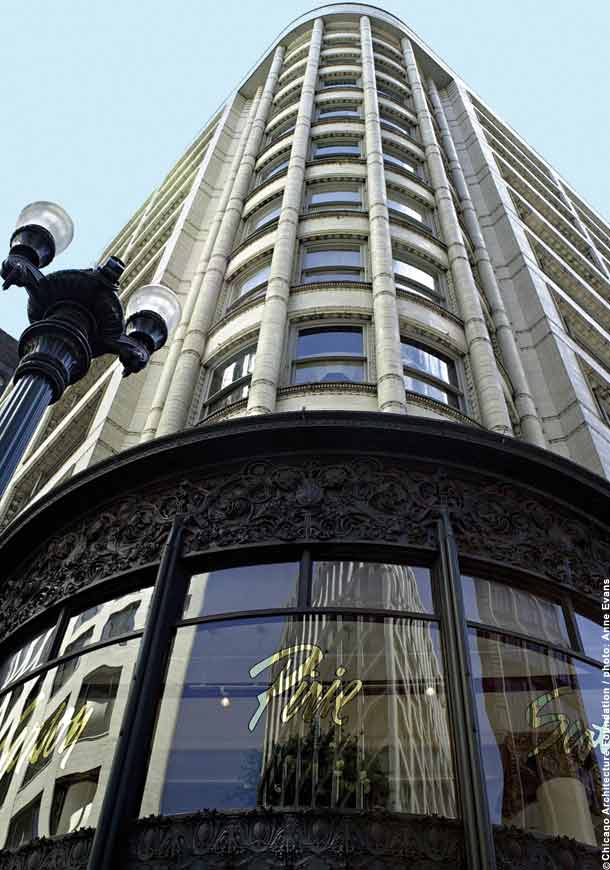
Sullivan’s penchant for ornamentation can be seen in the grillwork on the Carson Pirie Scott store (1899), 1 S. State Street.
National Historic Landmark
Statement of Significance (as of designation – May 15, 1975):
Constructed in three stages (1899, 1904, and 1906) the Carson Pirie, Scott Department Store is an original and practical design for a dry goods palace. Louis Sullivan’s style of organic ornament is fully developed in this building, which is remarkable for the integration of its horizontal composition and its detail; the 12 story addition (1906) by D.H. Burnham and Company is in keeping with his original plans.
Address:
1 S State St, Chicago, IL 60603
Wikipedia: https://en.wikipedia.org/wiki/Sullivan_Center
Chicago Board of Trade Building (LaSalle Street and Jackson Boulevard)
![Board of Trade Building in Chicago [photo: frankschrader.us]](https://www.travel1000places.com/wp-content/uploads/2020/12/chicago-board-of-trade-building-copyrighted-frankschrader-us.jpg)
Ornamentation from the Art Deco era is on display at the must-see Chicago Board of Trade Building (LaSalle Street and Jackson Boulevard), a 1930 work of Holabird and Root.
National Historic Landmark
Statement of Significance (as of designation – June 2, 1978):
Established in 1848, this institution is considered perhaps the first genuine commodity exchange, developed as a response to the instability and chaos that existed in the Chicago grain markets in the 1840s. This 45 story structure was erected 1928-1930.
Address:
335 S La Salle St, Chicago
Home Insurance Building
William Le Baron Jenney designed the world’s first “skyscraper” in Chicago in 1885: the Home Insurance Building, which was located at the northeast corner of LaSalle and Adams Streets.
Jenney’s technology, in which a thin outside skin was applied to an iron-and-steel frame, made possible the structures that make Chicago home to three of the world’s ten tallest buildings.
Building was demolished in 1931.
Wikipedia: https://en.wikipedia.org/wiki/Home_Insurance_Building
Willis Tower
Willis Tower ( former Sears Tower) (bounded by Wacker Drive, Jackson Boulevard, Franklin Boulevard and Adams Street) is one of the world’s tallest buildings, topping off at 1,450 feet.
Designed by Skidmore, Owings and Merrill and opened in 1974, Willis Tower consists of black aluminum and bronze-tinted glass on a structural steel frame, and it encompasses 101 acres of floor space.
The skydeck, which was renovated in 2000, offers a multi-media presentation and spectacular view of Chicago and beyond.
Visitor Information
Willis Tower Skydeck
Address
233 S. Wacker Dr., Chicago
AON Center, formerly the Amoco Building
Chicago’s second highest building is the 80-story AON Center, formerly the Amoco Building (200 E. Randolph Street), which also opened in 1974.
Designed by Edward D. Stone with Perkins and Will, the slender building stands out on the skyline and dwarfs its neighbor, the Prudential Building.
Address
200 E Randolph St, Chicago, IL 60601
John Hancock Center
The John Hancock Center (875 N. Michigan Avenue), another Skidmore, Owings and Merrill project, opened in 1969 and is distinguished by the steel cross-braces which make huge X’s on each side.
Three states, Illinois, Indiana and Wisconsin, are visible from the observatory on the 94th floor.
Address
875 N Michigan Ave, Chicago, IL 60611
Related Visitor Information: John Hancock Observation Deck (360 Chicago)
James R. Thompson Center
Chicago never stops building or challenging the architectural world and the public. One of the boldest of the city’s newer structures is the spectacular James R. Thompson Center, 100 W. Randolph Street, which has won both praise and criticism for architect Helmut Jahn. The massive red and blue, glass and granite structure houses 50 departments of state government and one of the most dazzling atriums found anywhere. Riding on the building’s glass elevator to the top floor is a must. An Illinois Artisans Shop and numerous restaurants are also found here.
Address
100 W Randolph St, Chicago, IL 60601
Related Visitor Information: James R. Thompson Center
Harold Washington Library Center
The Harold Washington Library Center, one of Chicago’s many public libraries, was designed by Hammond, Beeby and Babka and opened in 1991. This building encompasses all that is unique to Chicago architecture within a single structure. Combining the grid patterns of the early Chicago skyscrapers, the neoclassical details of the great white structures of the 1893 World’s Columbian Exposition and references to Daniel Burnham’s grand plan, the library is a lesson in Chicago architecture. The Harold Washington Library houses approximately two million books and includes the world’s largest children’s library, a public restaurant and a winter garden.
Address
400 S State St, Chicago, IL 60605
Website: https://www.chipublib.org/locations/34/
Millennium Park by Frank Gehry
Opened in July 2004, Chicago’s new Millennium Park is an award-winning center for art, music, architecture and landscape design that has become one of the City’s most popular destinations. The result of a unique partnership between the City of Chicago and the philanthropic community, the 24.5-acre park features two works by world-renowned architect Frank Gehry – the Jay Pritzker Pavilion, an outdoor music venue that seats 11,000 people, and the BP Bridge, a winding, serpentine footbridge that crosses Columbus Drive.
The BP Bridge is Gehry’s first.
Location
Downtown Chicago (the Loop) at Lake Michigan.
Related Visitor Information: Millennium Park
Adler Planetarium
National Historic Landmark
Statement of Significance (as of designation – February 27, 1987):
The Adler, which opened in 1930, was the first planetarium in the Western Hemisphere. It was given to the people of Chicago by Max Adler to enable everyone to “observe the heavenly bodies as heretofore only astronomers could do.” The planetarium was an attraction at the great Chicago exposition, “A Century of Progress” (1933-1934).
Address
1300 S. Lake Shore Drive, Chicago
Website: https://www.adlerplanetarium.org/
Art Institute of Chicago’s new Modern Wing and Nichols Bridgeway
Known as the Modern Wing, the sparkling temple of steel, glass and limestone is being built at the southwest corner of Monroe and Columbus Drives.
It will be the Art Institute’s largest structure since its familiar Beaux-Arts edifice along Michigan Avenue rose in 1893 atop rubble from the Great Chicago Fire. The new wing, as well as the Nichols Bridgeway (a pedestrian bridge linking the Art Institute and Millennium Park), were designed by celebrated architect, Renzo Piano of Italy.
Address
111 S. Michigan Avenue
Website: https://www.artic.edu/
NBC Tower
The design, by Adrian D. Smith of Skidmore, Owings, and Merrill, is considered one of the finest reproductions of the Art Deco style and similar to the GE Building in New York City. The tower is further enhanced by the use of limestone piers and recessed tinted glass with granite spandrels.
Address
455 N. Cityfront Plaza Drive , Chicago, Illinois 60611
Website: https://nbc-tower.com/
Marshall Field’s Building (now Macy’s)
National Historic Landmark
Statement of Significance (as of designation – June 2, 1978):
This 12 story granite building was designed to house the retail firm of Marshall Field, a pioneer of customer-service concepts.
Address
111 N State St, Chicago, IL 60602
Read more: Marshall Field’s Building / Macy’s on State Street
Shedd Aquarium
National Historic Landmark
Statement of Significance (as of designation – February 27, 1987):
Opened to the public in 1930, this was the first inland aquarium in the country to maintain a permanent collection of both fresh-water and salt-water fishes and other aquatic life. Made possible by the donations of John G. Shedd (1850-1926), it is one of the prime remaining structures from the second Chicago exposition, “A Century of Progress” (1934).
Address
1200 S Lake Shore Dr, Chicago
Website: https://www.sheddaquarium.org/
Wrigley Building
The architectural shape of the Wrigley Building is patterned after the Seville Cathedral’s Giralda Tower in Spain. However, the ornamental design of the building is based on an American adaptation of French Renaissance style. Mr. Charles Beersman, chief designer for the building’s architects, Graham, Anderson, Probst and White, used his talent and imagination to combine the two concepts.
The 425-foot (130 m) south tower was completed in April 1921 and the north tower in May 1924.
Read more: The Wrigley Building History
Glessner (John J.) House
National Historic Landmark
Statement of Significance (as of designation – January 7, 1976):
Completed in 1887, this house was designed by Richardson late in his career and represents the height of his Romanesque style. It was commissioned by John Glessner, president of International Harvester.
Address
1800 Prairie Avenue, Chicago
Website: https://www.glessnerhouse.org/

